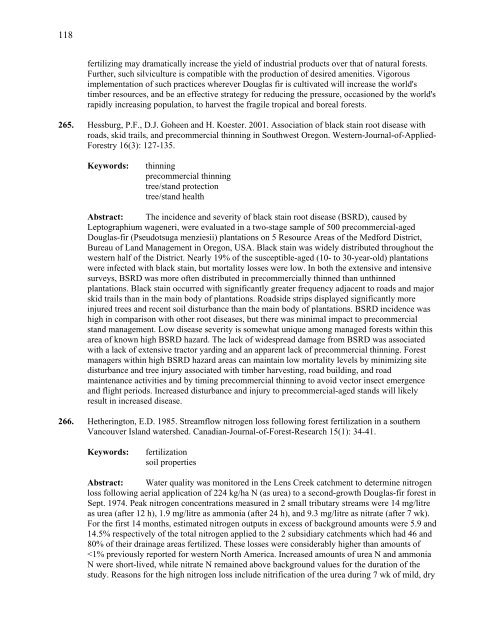IntensIve sIlvIculture - Forest Science Labs - Research Network ...
IntensIve sIlvIculture - Forest Science Labs - Research Network ...
IntensIve sIlvIculture - Forest Science Labs - Research Network ...
You also want an ePaper? Increase the reach of your titles
YUMPU automatically turns print PDFs into web optimized ePapers that Google loves.
118<br />
fertilizing may dramatically increase the yield of industrial products over that of natural forests.<br />
Further, such silviculture is compatible with the production of desired amenities. Vigorous<br />
implementation of such practices wherever Douglas fir is cultivated will increase the world's<br />
timber resources, and be an effective strategy for reducing the pressure, occasioned by the world's<br />
rapidly increasing population, to harvest the fragile tropical and boreal forests.<br />
265. Hessburg, P.F., D.J. Goheen and H. Koester. 2001. Association of black stain root disease with<br />
roads, skid trails, and precommercial thinning in Southwest Oregon. Western-Journal-of-Applied-<br />
<strong>Forest</strong>ry 16(3): 127-135.<br />
Keywords: thinning<br />
precommercial thinning<br />
tree/stand protection<br />
tree/stand health<br />
Abstract: The incidence and severity of black stain root disease (BSRD), caused by<br />
Leptographium wageneri, were evaluated in a two-stage sample of 500 precommercial-aged<br />
Douglas-fir (Pseudotsuga menziesii) plantations on 5 Resource Areas of the Medford District,<br />
Bureau of Land Management in Oregon, USA. Black stain was widely distributed throughout the<br />
western half of the District. Nearly 19% of the susceptible-aged (10- to 30-year-old) plantations<br />
were infected with black stain, but mortality losses were low. In both the extensive and intensive<br />
surveys, BSRD was more often distributed in precommercially thinned than unthinned<br />
plantations. Black stain occurred with significantly greater frequency adjacent to roads and major<br />
skid trails than in the main body of plantations. Roadside strips displayed significantly more<br />
injured trees and recent soil disturbance than the main body of plantations. BSRD incidence was<br />
high in comparison with other root diseases, but there was minimal impact to precommercial<br />
stand management. Low disease severity is somewhat unique among managed forests within this<br />
area of known high BSRD hazard. The lack of widespread damage from BSRD was associated<br />
with a lack of extensive tractor yarding and an apparent lack of precommercial thinning. <strong>Forest</strong><br />
managers within high BSRD hazard areas can maintain low mortality levels by minimizing site<br />
disturbance and tree injury associated with timber harvesting, road building, and road<br />
maintenance activities and by timing precommercial thinning to avoid vector insect emergence<br />
and flight periods. Increased disturbance and injury to precommercial-aged stands will likely<br />
result in increased disease.<br />
266. Hetherington, E.D. 1985. Streamflow nitrogen loss following forest fertilization in a southern<br />
Vancouver Island watershed. Canadian-Journal-of-<strong>Forest</strong>-<strong>Research</strong> 15(1): 34-41.<br />
Keywords: fertilization<br />
soil properties<br />
Abstract: Water quality was monitored in the Lens Creek catchment to determine nitrogen<br />
loss following aerial application of 224 kg/ha N (as urea) to a second-growth Douglas-fir forest in<br />
Sept. 1974. Peak nitrogen concentrations measured in 2 small tributary streams were 14 mg/litre<br />
as urea (after 12 h), 1.9 mg/litre as ammonia (after 24 h), and 9.3 mg/litre as nitrate (after 7 wk).<br />
For the first 14 months, estimated nitrogen outputs in excess of background amounts were 5.9 and<br />
14.5% respectively of the total nitrogen applied to the 2 subsidiary catchments which had 46 and<br />
80% of their drainage areas fertilized. These losses were considerably higher than amounts of<br />
















